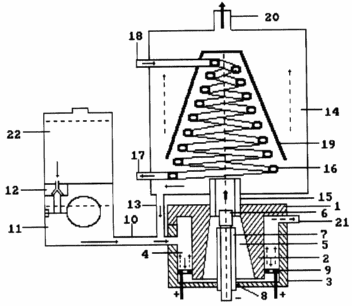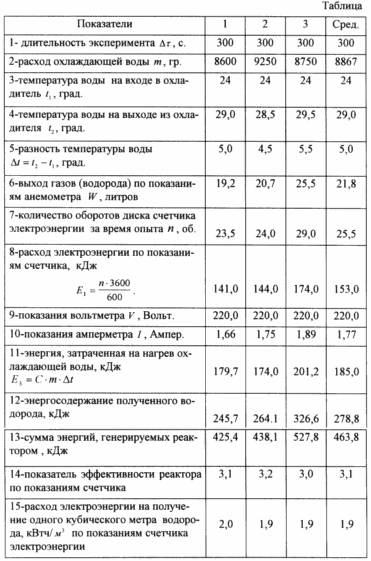| section Home
Production, Amateur Radio amateur Model aircraft, rocket- Useful, entertaining |
Stealth master
Electronics Physics Technologies invention |
space Mystery
Earth Mysteries Secrets of the Ocean Stealth section Map |
|
| Use of material is permitted for reference (for websites - hyperlinks) | |||
Navigation: => |
Home / Products Patents / In the section of the catalog / back / |
|
INVENTION
Russian Federation Patent RU2175027
![]()
DEVICE FOR HEAT, hydrogen and oxygen
Name of the inventor: Kanarev F.M .; Konarev VV .; Podobedov VV .; Garmashov AB
The name of the patentee: Closed Joint Stock Company "Neoenergiya"
Address for correspondence: 445028, Samara, Tolyatti, Closed Joint Stock Company "Neoenergiya".
Starting date of the patent: 1999.06.03
The invention relates to the physical and chemical technologies produce heat, hydrogen and oxygen. The device has a housing with an axial bore and the abutment and the lower cylindric cover which together form the housing communicating with the transconductance cell between a cathode and an anode cavities. A flat annular plate with openings located in the anode cavity. The cathode in the form of a cylindrical rod inserted in the dielectric rod, which is introduced into the chamber through a transconductance threaded hole in the bottom cover. Capacity for working solution with automatic control system of its level in the cathode chamber is connected to the anode cavity. Cooling chamber for conditioning steam and hydrogen evolution connected to the feed inlet of the working solution into the anode cavity. Nozzle for withdrawal of oxygen introduced into the top of the anode cavity. Pipe for supplying the gas-vapor mixture introduced into the cooling chamber through an axial hole threading into the housing. This setting allows you to produce hydrogen and oxygen by electric and thermal decomposition of water at the same time due to the energy of the plasma.
DESCRIPTION OF THE INVENTION
The invention relates to the physical and chemical technologies and techniques to produce heat, hydrogen and oxygen.
There are technical devices (see. Holstein AB, Serebryansky FZ Operation electrolysis plants for the production of hydrogen and oxygen. M .: "Energy", 1969) to produce hydrogen and oxygen.
Technical solution is known (see. U.S. Patent 3969214, C 25 B 1/02, 1976), comprising a housing, nozzle input working solution transconductance cell anode connected to the positive pole of the power source, a cathode connected to a negative power source.
and the prior art (see. No. 1,139,614 N England, cl. the C 01 B 13/06, 08.01. 1969), comprising a housing made of dielectric material with a through hole, a transconductance cell connections for input and output of the working solution, the anode connected to the positive pole of the power source and a cathode connected to the negative pole of the power source.
A drawback of known inventions is that to produce hydrogen and oxygen is only used process of electrolytic dissociation of water molecules and is not used its thermal dissociation process.
The technical solution of the problem is the production of hydrogen and oxygen by electrolytic and thermal decomposition of water at the same time due to the energy of the plasma, formed at the cathode.
Device for obtaining thermal energy of hydrogen and oxygen, comprising a housing made of dielectric material with a through hole, a transconductance cell connections for input and output of the working solution, an anode connected to the positive pole of the power source and a cathode connected to the negative pole of the power source characterized in that the housing with the axial opening has a lower cylindric tide and a lower cover forming together with the housing transconductance cell consisting of anode and cathode cavities interconnected in the lower part, a flat circular plate with openings located in the anode chamber, a cathode in the form of a cylindrical rod of a refractory material enclosed in a dielectric rod with a thread inserted in a transconductance cell with lower side through a threaded hole in the bottom cover to move vertically along the centerline of the device, a tank for working solution with a system of automatic control of its level in the cathode chamber connected to the anode cavity, a cooling chamber for condensing the vapor and the hydrogen evolution, the cavity of which is connected to the inlet flow of the working solution in the anode chamber, pipe for feeding gas mixture to the cooling chamber inserted threadedly into the axial hole of the body, fitting for the withdrawal of oxygen introduced into the upper part of the anode cavity.
The novelty of the claimed device due to the fact that automatic control of the solution level in the cathode chamber termoelektroliticheskogo provides maximum efficiency of decomposition of water into hydrogen and oxygen, and by the fact that the cooling and condensation of steam increases yield of hydrogen produced. Taken together, these features reduce the cost of electrical energy to thermal energy, hydrogen, and oxygen.
According to the patent and technical literature has not found a similar set of features for which considerably reduces energy costs for the production of hydrogen and oxygen, which gives an indication of inventive suggestions.
Brief Description of the drawing, which shows a general view of the device.
 |
An apparatus for producing hydrogen and oxygen comprising a housing 1 made of dielectric material with an axial bore and cylindric tide 2, the bottom cover 3 defining together with the housing an anode 4 and cathode 5 of the cavity, the rod cathode 6 is disposed in the dielectric rod 7, introduced into the cathode cavity 5 through the threaded hole 8 of the lid 3, a flat circular plate 9 with openings located in the anode chamber; pipe 10 to enter the working solution in the device connected to the float chamber 11 and the level controller 12 via the tube 13 - with the coolant cavity 14; and cooling the cathode chamber are communicated with each other via pipe 15; Cooler 14 comprises a tube formed into a spiral configuration with 16 conical inlet 17 and outlet nozzles 18 for the coolant, the reflector 19 uncondensed vapor withdrawal conduit 20 for hydrogen from the cooler 14; tube 21 for withdrawal of oxygen from the anode cavity. |
The device operates as follows. The working solution is poured into the container 22 from which it passes through the dosing device 12 and the float chamber 11 to the anode chamber 4 and cathode - 5. After filling the reactor solution reaches a predetermined level, the float of the float chamber 11 closes the inlet of the metering device. Next, turn on the electrical network, and gradually increases the voltage to the advent of a stable plasma in the cathode zone 6. The resulting gas-vapor mixture at the cathode is supplied to the cooler 14. The steam in contact with the cooled surface of the cooling tube, is condensed, and the separated gas is discharged out of the reflector 19 and is supplied to the outlet nozzle 20. The steam condensate is supplied to the anode chamber 4 via conduit 13 and inlet 10. The oxygen evolved at the anode 9, enters the top of the anodic chamber 4 and removed therefrom through the tubing 21.
Since the level of solution in the reactor is controlled automatically, the device for producing hydrogen and oxygen is in automatic mode. As the flow of the solution, it is filled in a receptacle 22.
SUMMARY occurring physical and chemical processes is that the electric field between the cathode area repeatedly reduced with respect to the anode area is formed starting focused on the cathode, the flow of alkali metal ions. Having a stock of kinetic energy when moving toward the cathode, alkali metal ions knock out atoms from the hydrogen protons of water molecules. Upon reaching the cathode, the protons, electrons and become hydrogen atoms formed by radiating photons which form atomic hydrogen from the plasma temperature of 5000 ... 10,000 o C. The energy of the plasma and a source of thermal dissociation of water into hydrogen and oxygen and a source of auxiliary energy, the presence of which is easily fixed energy of the heated solution, evaporating the collected water and gases. At the same time at the anode electrolytic process is oxygen evolution.
Thus, at the cathode hydrogen plasma heat source is transmitted aqueous solution, and a source of atomic and molecular hydrogen and oxygen simultaneously.
The effectiveness of the device determines the overall efficiency, taking into account the electrical energy introduced into the device, thermal energy transferred by steam coolant and energy contained in the released hydrogen. The table shows the results of this test device.

CLAIM
Device for obtaining thermal energy of hydrogen and oxygen, comprising a housing made of dielectric material with a through hole, a transconductance cell connections for input and output of the working solution, an anode connected to the positive power supply pole, and its cathode connected to the negative supply pole supply, characterized in that the axial hole has a lower cylindric tide lower cover forming together with the housing transconductance cell consisting of anode and cathode cavities interconnected in the lower part, a flat circular plate with openings located in the anode chamber, a cathode in the form of a cylindrical rod of a refractory material enclosed in a dielectric rod with a thread inserted in a transconductance cell with lower side through a threaded hole in the bottom cover to move vertically along the centerline of the device, a tank for working solution with a system of automatic control of its level in the cathode chamber connected to the anode cavity, a cooling chamber for condensing the vapor and the hydrogen evolution, the cavity of which is connected to the inlet flow of the working solution in the anode chamber, pipe for feeding gas mixture to the cooling chamber inserted through the thread hole casing pipe for withdrawal of oxygen introduced into the top of anode cavity.
print version
Publication date 02.03.2007gg




Comments
Commenting, keep in mind that the content and the tone of your messages can hurt the feelings of real people, show respect and tolerance to his interlocutors, even if you do not share their opinion, your behavior in terms of freedom of speech and anonymity offered by the Internet, is changing not only virtual, but real world. All comments are hidden from the index, spam control.